|
|
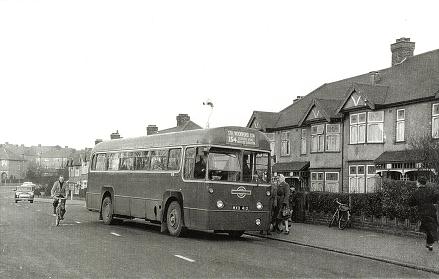 Red RF routes Red RF routes
Route 254
Page last updated 14 February
2016
Loughton's post-war panhandle route, provided with RFs
earlier than planned when winter 1953 timetable reductions allowed
some to be squeezed out from the schedules of the routes initially
converted.
RF433,
later a 'last 236' bus, in a peaceful
scene from the late 50s. The route had
been extended to South Woodford in January 1958 and the bus is
seen opposite Station Road in Roding Valley. RF433 ran
the 254 again on 9 September
2007.
Photo © C
Carter, Peter Gomm collection
Dates of RF
operation
7 Oct 53 to 9 Apr 76
Converted to OMO 3 Oct 65
(total 22 years 6 months, of
which 12 years crew operation).
Destinations
BUCKHURST HILL and LOUGHTON STATION (7 Oct 53 to 7 Jan
58)
SOUTH WOODFORD and LOUGHTON STATION (8 Jan 58 to 9 Apr
76)
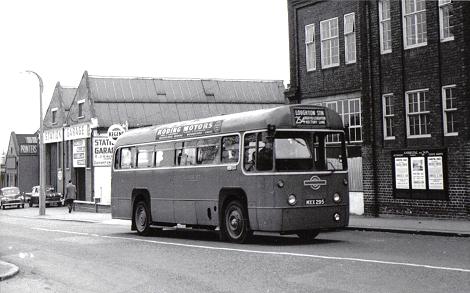 Reason for single-deck operation Reason for single-deck operationThe use (twice on every journey!) of the very low bridge in
Roding Road immediately east of Loughton Station precludes the use
of double-deckers.
Route history
One of the new routes which expanded London's suburban bus
services once resources were available after the second world war,
the 254 brought single-deckers back to Loughton garage after a gap
of four years.
Five years later, on 11 April 1959, RF407
heads for Loughton Station. Despite the new blinds that would
have been produced for the route extension the previous year,
this one is still in the style of the early 1950s. Thanks to
David Trumble, we know that the bus is in Old Station Road (outside
Ambrose the Auctioneers ) just before it meets High Road. The
bus has just passed Loughton Station and is on route via Debden
before returning to Loughton Station.
Photo © Alan Cross, Peter Gomm
collection
The new route started on 18 January 1950, serving housing west
of Debden, and ran a 'panhandle' shape, from Buckhurst Hill Station
via Loughton Way, then a loop passing Loughton Station,
via Loughton High Rd and Loughton garage, Debden Station and
back to Loughton Station. Initially operated with elderly
11T11s, these were first replaced by ex-Green Line 9T9s, then on 14
Nov 51, 10T10s made available by the first Green Line RFs. In
February 1953, these were in turn replaced by TDs from Muswell Hill
(themselves replaced by new RFs), but still Loughton's
long-standing demand for modern buses was unmet.
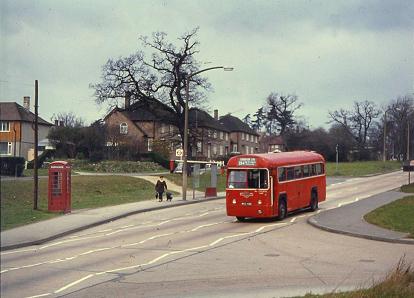 Finally, the faster running times of RFs compared
with their predecessors, together with the release of training
buses at the end of conversion, meant that Loughton could receive
nearly-new RFs in October 1953. The allocation moved
over the road when the new Loughton Garage opened on 2 Dec
53.
From 8 Jan 58, the 254 was extended south every half hour
on Monday to Saturday over new roads to serve Woodford and
South Woodford Stations, with alternate journeys running the
original route. Initially, the South Woodford journeys did
not cross the railway to serve Buckhurst Hill Station, but this
changed 14 months later with a double-run to the forecourt.
The route was converted to one-man operation in October 1965,
at the same time as the creation of new OMO route 20B. Thanks to
Nicholas Owen for pointing out that there was a subtle route change
at the same time, with the journeys passing Loughton calling in at
the station itself, rather than just stopping in Old Station Road
(northbound) or Alderton Hill (southbound) as before. From 14
Jun 69, additional Monday to Friday journeys were introduced
between Buckhurst Hill Station and Loughton Garage to replace the
journeys to Buckhurst Hill on the 20 B, but the Saturday
frequency was reduced. On 19 Oct 75, improvements to the
North Circular, previously crossed at traffic lights, meant that
the route had to be diverted and now ran in to South Woodford from
the east.
Having passed Loughton
Station inbound from Buckhurst Hill, RF503 passes Debden Station
before terminating back at Loughton Station. The route always
operated in a 'P' shape, rather than a backwards
'S'. Photo © John
Parkin
RF operation outlasted the 20 B, the 254 retaining RFs
until April 1976, when the route was converted to to SMS
operation. At the end, though, RTs lasted longer at Loughton,
continuing on the 20 A for another six months.
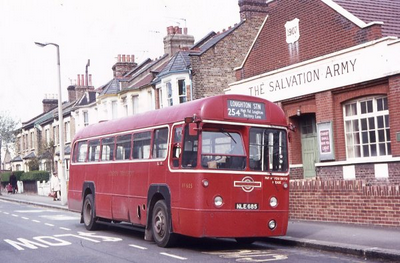 In 1979, a simplified version of route was
renumbered 255, the last day of the 254 being 30
March. The 255 ran from Loughton Garage via Debden and
Loughton Station to South Woodford; the Loughton Garage to
Buckhurst Hill section was replaced by a short-lived Waltham Cross
version of the 250. The 255 itself only lasted until
September 1982, when the roads were covered by revised routings of
the 167 and 250. Certain 254 roads east of Loughton are
no longer served by TfL, as the whole area is outside
the London boundary. In 1979, a simplified version of route was
renumbered 255, the last day of the 254 being 30
March. The 255 ran from Loughton Garage via Debden and
Loughton Station to South Woodford; the Loughton Garage to
Buckhurst Hill section was replaced by a short-lived Waltham Cross
version of the 250. The 255 itself only lasted until
September 1982, when the roads were covered by revised routings of
the 167 and 250. Certain 254 roads east of Loughton are
no longer served by TfL, as the whole area is outside
the London boundary.
The last day of operation of
RFs on the 254 was 9 April 1976, when
RF685 is seen ready for departure from South Woodford for
Loughton. RFs returned on 9 September
2007 for a day. RF685 is one of the green RFs repainted
red when at Muswell Hill in 1969. It subsequently worked on
the 291 at BK before allocation to
L.
RF route in
detail, with timing points
BUCKHURST
HILL LT Station, Victoria Road, Roding Lane,
Loughton Way, Valley Hill, Roding Road, Alderton Hill, Loughton Station Approach, Old
Station Road, Loughton High Road, Church Hill, Loughton LT Garage, Rectory Lane,
Debden LT Station,
Chigwell Lane, Oakwood Hill, Roding Road, Alderton Hill, Station
Approach, LOUGHTON LT Station (7 Oct 53 to 7
Jan
58)
SOUTH WOODFORD LT Station,
(anti-clockwise) Daisy Road, Cowslip Road (return direct),
Maybank Road (now Mulberry Road and severed by the North Circular),
Latchett Road, St Barnabas Road, Hillside Avenue, Hillside Avenue Snakes Lane (for
Woodford LT Station), Hillside Avenue, Buckhurst Way, Albert Road,
Buckhurst Hill LT
Station (double run from 13 May 59: Roding Lane,
Victoria Road, Buckhurst Hill LT
Station, Victoria Road, Roding Lane), Loughton Way,
Valley Hill, Roding Road, Alderton Hill, Loughton Station Approach, Old
Station Road, Loughton High Road, Church Hill, Loughton LT Garage, Rectory Lane,
Debden LT Station,
Chigwell Lane, Oakwood Hill, Roding Road, Alderton Hill, Station
Approach, LOUGHTON LT Station (8 Jan 58 to
7 Jan 62)
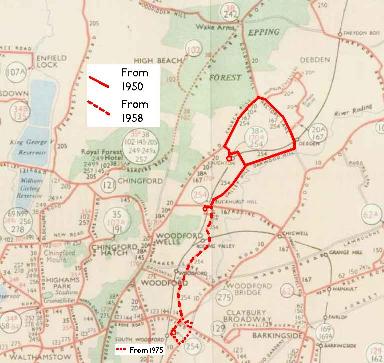 SOUTH
WOODFORD LT Station, Daisy Road (clockwise, return
via Cowslip Road), Maybank Road, Latchett Road, St Barnabas
Road, Hillside Avenue Snakes
Lane (later Woodford
Station), Hillside Avenue, Buckhurst Way, Albert Road,
Roding Lane, Victoria Road, Buckhurst
Hill LT Station, Victoria Road, Roding Lane,
Loughton Way, Valley Hill, Roding Road, Alderton Hill, Loughton Station Approach
(Station Approach, Loughton
Station, Station Approach, from 3 Oct 65), Old
Station Road, Loughton High Road, Church Hill, Loughton LT Garage, Rectory Lane,
Debden LT Station,
Chigwell Lane, Oakwood Hill, Roding Road, Alderton Hill, Station
Approach, LOUGHTON LT Station (8 Jan 62 to
18 Oct 75) SOUTH
WOODFORD LT Station, Daisy Road (clockwise, return
via Cowslip Road), Maybank Road, Latchett Road, St Barnabas
Road, Hillside Avenue Snakes
Lane (later Woodford
Station), Hillside Avenue, Buckhurst Way, Albert Road,
Roding Lane, Victoria Road, Buckhurst
Hill LT Station, Victoria Road, Roding Lane,
Loughton Way, Valley Hill, Roding Road, Alderton Hill, Loughton Station Approach
(Station Approach, Loughton
Station, Station Approach, from 3 Oct 65), Old
Station Road, Loughton High Road, Church Hill, Loughton LT Garage, Rectory Lane,
Debden LT Station,
Chigwell Lane, Oakwood Hill, Roding Road, Alderton Hill, Station
Approach, LOUGHTON LT Station (8 Jan 62 to
18 Oct 75)
Map © London Transport
1955
SOUTH WOODFORD STATION Cowslip
Road, Daisy Road, Maybank Road (now Mulberry Way), George
Lane, Chigwell Road, Maybank Road, Gordon Road, (return via
Latchett Road, Southend Road (A406 slip road) to Chigwell
Road), St Barnabas Road, Woodford Station, Hillside Avenue,
Buckhurst Way, Albert Road, Roding Lane, Victoria Road,
Buckhurst Hill Station,
Victoria Road, Roding Lane, Loughton Way, Valley Hill, Roding Road,
Alderton Hill, Station Approach, Loughton Station, Station Approach, Old
Station Road, Loughton High Road, Church Hill, Loughton Garage, Rectory Lane,
Debden Station, Chigwell Lane,
Oakwood Hill, Roding Road, Alderton Hill, Station Approach,
LOUGHTON STATION (19 Oct 75 to 9 Apr 76)
Frequency
| Year |
Mon-Fri |
Sat
|
Sun |
|
1951
|
10-15 mins
|
10-15 mins
|
20 mins
|
|
1953
|
10-15 mins
|
8-15 mins
|
15-20 mins
|
|
1959
|
30 mins *
|
30 mins *
|
30 mins †
|
|
1964
|
30 mins *
|
30 mins *
|
30 mins
|
|
1969
|
30-32 mins *
|
26-30 mins *
|
32 mins
|
|
1971
|
30-32 mins *
|
24 mins *
|
32 mins
|
|
1976
|
60 mins *
|
30 mins *
|
63 mins
|
* more frequent between Loughton - Buckhurst Hill
† Loughton - Buckhurst Hill only
From Loughton Station, and via Loughton Station, the route took
about 27 minutes to reach Buckhurst Hill and 42 minutes to
reach South Woodford. The July 1967 timetable is
here.
Faretable
The 1965 faretable is here.
RF allocation
Loughton received no new RFs for the 254, as noted
above. Its initial allocation comprised RFs 289, 293, 294,
481, 483, 485, 512.
PVR 1953 (Oct): Mon-Fri 6, Sat 7, Sun 4
PVR 1954 (May): Mon-Fri 5, Sat 6, Sun 3
PVR 1956 (Oct): Mon-Fri 5, Sat 6, Sun 2
PVR 1958 (Jan): Mon-Fri 6, Sat 7, Sun 2
PVR 1965 (Oct, OMO): Mon-Fri 7, Sat 9, Sun 3
PVR 1969 (Jun): Mon-Fri 8, Sat 7, Sun 3
PVR 1971 (Jul): Mon-Fri 8, Sat 6, Sun 2
Memories
John McAlpine writes: I
worked in Loughton (not on the buses) 1969-1976 during the time of
RFs on the 254, and was fascinated by this weird route. Was it
unique, (possibly in the world?) in that it travelled along the
same road, in the same direction, and showing the same destination,
twice on each journey! How the drivers remembered which way
to turn coming out of Loughton Station Approach, and at the
southern end of Roding Road - and which stops to use, I'll never
know; but suspect an occasional wrong turn was made.
It probably helped that there were separate bus stops for each
segment, and this saved the passengers from having to ask the
driver which way they were going to turn at the end of Roding Road,
or (in the other direction), whether they were going on to Loughton
High Road, (if you hadn't noticed from which direction they had
turned into Roding Road); and not many people bothered with the
buses terminating at the station, as it wasn't much of a walk from
here due to the footpath shortcut alongside the railway.
The only problem was, if you wanted to go from the Loughton Way
area to Debden or vice versa, you'd have to change buses in Roding
Road by crossing the road; or go around three-quarters of the loop,
which was slower and probably more expensive [the faretable confirms that it was for some
destinations]. Despite this complexity, all the local people
seemed to understand it perfectly, and always got to where they
wanted to go. I suspect quite a bit of thought went into planning
this route, for if it had started the loop clockwise there would
have been buses going through Roding Road both ways showing both
destinations; even more confusing! As it was, you would still
sometimes spot an obvious non-local wandering from stop to stop in
Roding Road and scratching their head.
Re-creation
|
|